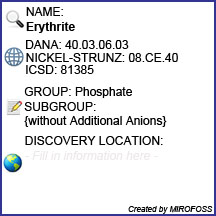

| Mineral Name | Conichalcite |
| First Discovered | 1849 |
| Nickel-Strunz Classification | 08.BH.35 |
| Dana Classification | 41.05.01.02 |
| ICSD | 64694 |
| Mineral Group | Phosphates |

| Cleavage | None |
| Colour(s) | Yellowish green, Emerald green |
| Specific Gravity | 4.1 |
| Diaphaneity | Sub translucent |
| Fracture | Brittle - Uneven - Very brittle fracture producing uneven fragments |
| Mohs Hardness | 4.5 |
| Luminescence | Non-fluorescent |
| Lustre | Vitreous, greasy |
| Streak | Light green |
| Habit(s) | Fibrous to Massive to Reniform |
| Radioactivity | Non-radioactive |
| Magnetism | Non-magnetic |

The following health hazards should be noted when handling conichalcite:
 |
ENVIRONMENTAL HAZARD Conichalcite contains the element Arsenic which is known to cause long term environmental effects. |
 |
TOXIC Conichalcite contains the element Arsenic which is fatal if ingested. |

The following image shows the Elemental breakdown of the mineral conichalcite along with the mineral crystal structure.


| Crystal System | Orthohombic |  |
| Class | Disphenoidal | |
| Axial Ratios | a : b : c = 0.7994 : 1 : 0.6297 | |
| Morphology | Typically radial fibrous aggregates, botyroidal to reniform crusts, massive | |
| Optical Data Type | Biaxial (+/-) | |
| Pleochroism (x) | Green | |
| Pleochroism (y) | Yellowish green | |
| Pleochroism (z) | Bluish green | |
| RL Values | nα = 1.778 - 1.800 nβ = 1.795 - 1.831 nγ = 1.801 - 1.846 |  |
| Max Birefringence | δ = 0.034-0.046 (See colour chart at right) | |
| Surface Relief | Very high | |

Conichalcite can be referenced in certain current and historical texts under the following six names:
The mineral conichalcite can be translated into the following select languages:
| Arabic | Bulgarian | Chinese (Sim) | 砷钙铜矿 | ||
| Croatian | Czech | Danish | |||
| Dutch | Esperanto | Estonian | |||
| Finnish | French | German | Konichalcit | ||
| Greek | Hebrew | Hungarian | |||
| Italian | Conicalcite | Japanese | コンニチャルチャイヅ | Korean | 컨니찰사읻 |
| Latin | Lithuanian | Norwegian | |||
| Persian | Polish | Staszycyt | Portuguese | ||
| Romanian | Russian | Конихальцит | Slovak | ||
| Spanish | Conichalcita | Swedish | Tagalog | ||
| Turkish | Ukrainian | коніхальціт | Vietnamese |

Conichalcite can be found in a few places around the world. The map below shows major documented concentrations of conichalcite:


 |
The MIROFOSS database offers free printable geological identification tags for personal and non-profit use. These tags can be used to properly identify mineral samples in your collection. -Click here- to download a full size jpeg image for a erythrite identification tag; which can be printed on paper or used with a plastic laser printer. |
 |
What's this? What can I do with it? |

| Crystallography | Sakai, S., Yoshiasa, A., Sugiyama and Miyawaki, R. (2009): Crystal structure and chemistry of conichalcite, CaCu(AsO4)(OH). Journal of Mineralogical and Petrological Sciences, 104, 125-131. |
| Crystallography | T. Djordjević and U. Kolitsch (2008): Conichalcite revisited: Structural and chemical characterisation of a sample from the Maria Catalina mine, Copiapó Province, Chile. Poster, Annual Meeting of the DMG, Berlin, Germany, September 14-17, 2008; CD with abstracts, Abs. no. 331. |
| History | Reddy, B.J.; Frost, R.L.; Martens, W.N. (2005): Characterization of conichalcite by SEM, FTIR, Raman and electronic reflectance spectroscopy. Mineralogical Magazine 69, 155-168. |
| History | Anthony, J.W., Bideaux, R.A., Bladh, K.W., and Nichols, M.C. (2000) Handbook of Mineralogy, Volume IV. Arsenates, Phosphates, Vanadates. Mineral Data Publishing, Tucson, AZ, 680pp.: 125. |
| History | Palache, C., Berman, H., & Frondel, C. (1951), The System of Mineralogy of James Dwight Dana and Edward Salisbury Dana, Yale University 1837-1892, Volume II. John Wiley and Sons, Inc., New York, 7th edition, revised and enlarged, 1124 pp.: 806-809. |
| History | Canadian Mineralogist (1969): 7: 561-577. |
| Geograpcial Data | Mindat.org. Retrieved on 2012-06-20 |
| Physical Identification | Webmineral.com. Retrieved on 2012-06-19 |
| June 20, 2012 | The last time this page was updated |
| ©2017 MIROFOSS™ Foundation | |
 |